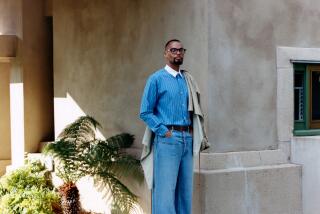THE SELECTED LETTERS OF MARIANNE MOORE.<i> By Marianne Moore</i> .<i> Alfred A. Knopf: 608 pp., $35</i>
- Share via
Ezra Pound amended and corrected T.S. Eliot into producing the definitive version of his masterpiece, “The Waste Land.” As the magisterial Muse of Modern Poetry, Pound did less well by Marianne Moore. In 1919, just feeling her way into his company and that of her other peers, Eliot, William Carlos Williams, Wallace Stevens, she was deferential enough to smooth out:
You are right, that swiftmoving sternly
Intentioned swaybacked baboon is nothing to you and the chimpanzee.
into:
You are right about it; that wary,
Presumptuous young baboon is nothing to you and the chimpanzee.
and to lard out:
The little dish, dirt brown, mulberry
White, powder blue or oceanic green--is half human and any
Thing peacock is “divine.”
to:
the little dishes, brown, mulberry
or sea green are half human and waiving the matter of artistry,
anything which can not be reproduced, is “divine.”
Nobody, not even Pound, could pin down Moore’s poetry, let alone improve it. Her astonishing “Rhyme on a Jellyfish,” written at 22, begins: “Visible, invisible / A fluctuating charm. . . .” It was she, as well, only she left out the sting.
In college, perhaps, she was not fully aware of the steely line that was to run through her apparently fanciful poems about the odd, bright colors of the world or of the wildness within her restraint. In fact, she was poetry’s demon skater--her tall, stiff figure in scarves, brooches and decorous skirts all the more terrifying, in its blitz across the ice, because of its entire lack of aerodynamics or pliability.
Unawareness, in any case, did not last long. The 400-odd letters collected here, out of some 30,000 that survive, depict a woman and an artist quite in command of her nurturing paradoxes. Courteous, kind and unyielding, she cultivated an old-fashioned restraint in both demeanor and diction--in everything except imagination, in fact--while frequenting circuses and zoos and occupying, as poet, critic and editor, the forefront of the Modernist 1920s and ‘30s.
Already in 1921, she wrote of the perilous seriousness of her gaudy artifice. “As for shades and overtones, I am ruled by them and escape from them with my life by a hairsbreadth and I cannot be much with people who are not as unhealthily impressionable and implacable as I am myself. . . .” Twenty years later she wrote with moving directness--as a rule, her letters are a mix of small revelation and large reticence--to her beloved protege and disciple, Elizabeth Bishop.
Bishop had written the word “water-closet,” and Moore lit on it, less to rebuke than to declare her credo. Many of her Modernist peers, not to mention the succeeding literary generations, used graphic language and images in a way that was not so much offensive to her, though it could be that as well, as it was irrelevant. “I say to them,” she wrote, “I can’t care about all things equally, I have a major effect to produce, and the heroisms of abstinence are as great as the heroisms of courage, and so are the rewards.”
A picturesquely eccentric aura enveloped Moore in her later years. The media took her up, and she was asked to write pieces for the women’s magazines, to think up a name for what became the Ford Edsel and to throw out the ball at the opening of the baseball season.
She was an amiable fit for the popular image of the “poetess.” She tolerated it, possibly enjoyed it--she liked circuses, after all, and why not, for a moment, climb into the ring?--but it had nothing to do with a commitment and a choice as unfrivolous as that of the other Modernists. Her tricorn hat was no less a disguise than Eliot’s bankerly garb and loan-denying grimace or Wallace Stevens’ jovial steak lunches with his insurance colleagues. A disguise that was also, in fact, the person wearing it.
Stevens, the letters reveal, was the contemporary to whom she felt closest artistically, though not personally. Her poems, she tells a friend, were “a chameleon attempt to bring my product in some sort of compatibility with Wallace Stevens.” And to Stevens himself she pays a revealingly direct tribute--one that seems to reflect something of her feelings about her own life and work. Congratulating him on a volume, “Owl’s Tribute,” she writes:
“The world probably is not owl enough to thank you for troubling about it; but an unkilled and tough-lived fortitude is a great help to us, conveyed as it is by your disguises, and may I say as the tenantry say to still persisting members of an aristocracy, ‘long life to it,’ to this hero which you exemplify.”
To return to the Bishop letter, it exemplifies one of the pleasures of this collection, segueing from artistic statement to the many mock-serious passages that mark the person in deliberate distinction to the artist. From water-closet, Moore goes on to rump.
“If I tell Mother there is a feather on her dress and she says, ‘On my back?’ I am likely to say ‘No, on your rump.’ . . . But in my work, I daren’t risk saying, ‘My mother had a feather on her rump,’ ” she writes.
“Mother”--Mary Warner Moore--with whom the unmarried Moore lived until the former’s death at 85, is a fascinating presence in the letters. Moore was devoted to her, cared for her when she was ill, shared with her a considerable social-artistic life and consulted her about her writing. In some of Mary’s formidably phrased interventions, we hear the poet herself.
“I wouldn’t publish,” Mary offers when Moore suggests bringing out an early collection. “Never?” Moore asks. “After you’ve changed your style,” Mary replies. “You would omit all these things I prize so much?” “Yes, they’re ephemeral.”
Mary’s punctilious courtesy surpasses even Moore’s. After a boring visitor leaves, she says she is afraid she drove him out. Moore reminds her that she had tried to delay him. “Yes,” Mary says, “but he knew that I delayed him out of contrition for not wanting him.”
The letters collected here include some written home from Bryn Mawr, where Moore flourished and had a number of close and sometimes romantic friendships. In later life, her closest attachments were to women, particularly to the writers Bryher and Hilda Doolittle (H.D.), who were lovers. She met them in England, corresponded with them, and they introduced her to the English literary scene and to Pound and Eliot.
The letters cover her start in New York in 1915, where she was quickly accepted by the avant-garde, and the publication of her first two collections in the early 1920s. They cover her years as editor of the literary magazine the Dial, her retirement with her mother to Brooklyn after the magazine folded, her writings, pastimes, friendships with other poets and her mother’s illness and death.
It is a rich selection with biographical passages between each section and rather skimpy footnotes. Many of the letters are to her brother, John, a Navy chaplain, who gave staunch moral and some financial support to his sister and mother, and in whom she found something of a confidant. She did not exactly kick her shoes off, but she did loosen the laces a little.
She is circuitous and indirect. She navigates the glancing surfaces of things, capturing her life as she captures flora and fauna. Yet her writing is so astonishingly faceted and her observations so ingenious as to give us in these letters a fascinating and often moving portrait of a woman, a poet and a literary milieu.
One letter praises a recitation by the extravagantly showy and mannered English poet Edith Sitwell and her equally showy brothers, Osbert and Sacheverell. Nothing more acute or more touching could be said of Moore herself:
“How much is expected of you--to think, to ornament the scene and be invulnerable.” No better portrait has been made of Moore herself.
More to Read
Sign up for our Book Club newsletter
Get the latest news, events and more from the Los Angeles Times Book Club, and help us get L.A. reading and talking.
You may occasionally receive promotional content from the Los Angeles Times.









